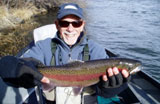Description
This fly has been featured here previously
(see fly archive on GBF’s Web site:
http://www.gbflycasters.org/fly%20tying/patterns/Wiggle_Tail_Nymph/Wiggle_Tail_Nymph.htm.
I decided to use it again because it’s such
a versatile pattern, and because GBF has
many new members who might like to try still
water fishing. The Wiggle Nymph will, if
fished properly, produce results even for
beginners.
For those who don’t know Jay Fair, he is
known as the “guru” of fly fishing (and dark
side fishing) on Eagle Lake, where there is
a special strain of fish sometimes called
“Eagle Lake Trout.” These fish are large and
they fight hard— but they can be notoriously
difficult to catch. Suffice it to say that
Jay has been around a long, long time. Over
the years he has developed a series of flies
that work—really work—for Eagle Lake fish.
Not surprisingly they work elsewhere too—
meaning anywhere that trout or bass will
grab something that moves enticingly through
the water and looks something like a leech,
damsel, or whatever lives in the
neighborhood. It is my “go to” fly for any
still water venue.
Through his company, called Eagle Fly
Fishing, Jay has marketed many products as
well as his patterns. One of his more
remarkable products is a line of crystal
chenille called “shuck.” It comes in many
beautiful fishy colors (e.g., burnt orange)
and in three different sizes: long shuck;
short shuck; and now baby shuck. I must
admit to a bit of bias here, since I am a
member of the Jay Fair “Pro Team,” but I
don’t think anyone will disagree with me
when I say that Jay’s materials are of
excellent quality and the range of choices
is broad. If you’d like to see a list of Jay
Fair products, just “Google” on “Jay Fair
products” or “Eagle Fly Fishing.”
The Wiggle Nymph is a sparsely tied fly —
too much material will adversely affect the
fly’s motion in the water, which is clearly
the key its success. It is suggestive of
damsels and leeches, and can be tied in a
variety of colors and color combinations.
For this month’s pattern we will tie it in
olive (I used burnt orange last time).
Tying Instructions
|
1.
Smash the hook barb. Wrap
4 or 5 turns of lead or
substitute on the shank and
cover hook and lead with thread
back to bend (just above back of
barb).
|
 |
2.
Tie on a tail of marabou. Use a ¼”
section from the mature part of the
plume. The tail should be 1” to 1 ¼” in
length. Resist the urge to use more
marabou and be sure the length is
correct.
|
 |
3.
At the same point, tie in
a short piece of olive baby
shuck and an olive saddle or
neck hackle with barbule length
equal to the hook gape. Tie the
hackle in by the tip.
|
 |
4.
Wrap the baby shuck
forward to a point about 1/16”
behind the hook eye; tie it off
there.
5.
Wrap the hackle forward,
using only 4 wraps. Tie it off
at the same spot as the baby
shuck. This is important: leave
enough room for a nice, small,
smooth head.
6.
Whip finish at the head and
apply a tiny drop of head cement
or super glue.
|
 |
|
Tying Tips
-
When forming the head of the fly
try to end up with a cone-like
shape. Avoid making too many
wraps. When doing your whip
finish, move rearward with each
turn of the knot, ending up at
the rear of the head.
-
Before learning to use a whip
finisher, learn to do the whip
finish knot by hand. There are a
number of reasons for this hint,
including the probability that
at some point you will have
forgotten to include your whip
finisher in your traveling tying
kit. Also, by learning how to
tie the knot properly, you will
better understand what the whip
finisher does and does not do.
It’s not an easy knot to learn,
but once the movement is
understood it will become
intuitive.
Note: here's
a link you can copy & paste into your web browser's address window to Sexyloops
website with animated instructions:
http://www.sexyloops.com/flytying/whipfinish.shtml
Or, you can
just Google: "whip finish" and get a bunch of websites with various techniques
and tools demonstrated.
The Wiggle
Tail Nymph moves with graceful motion through the water. Before you fish it, wet
it well and move it around in the water (on your leader, of course) in front of
yourself by moving the tip of your rod. You’ll see why this fly is so inviting
to fish — and, you’ll better understand how to retrieve it once you cast it to
your intended target. Now, wiggle on over to your vise and crank a few of Jay’s
gems and…

|
|

